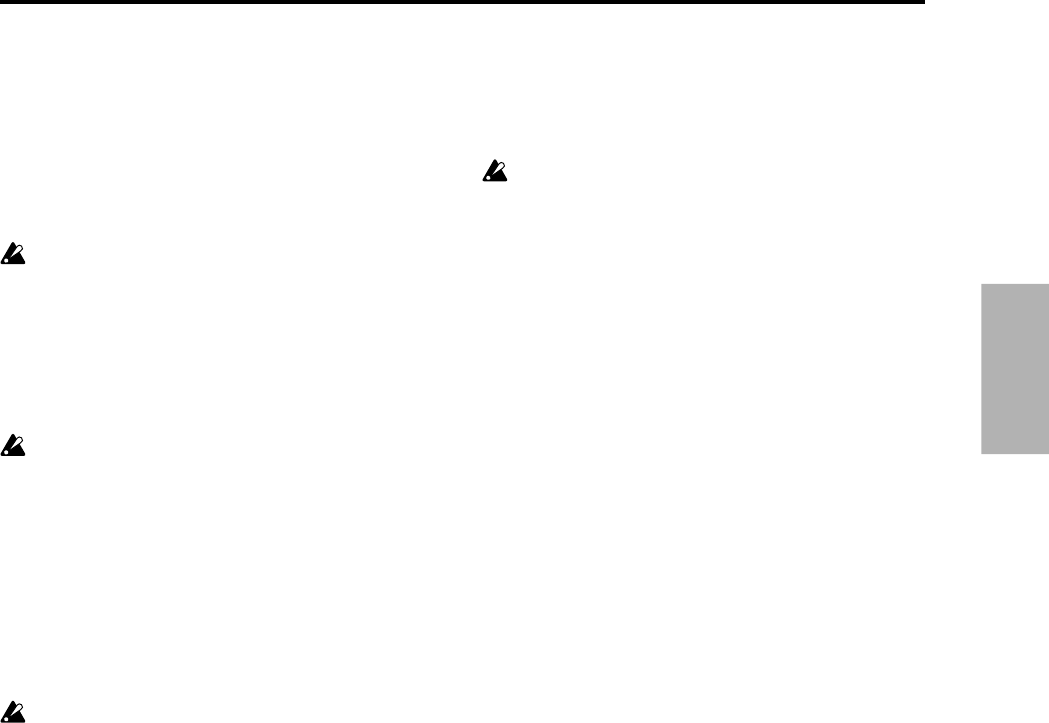
17
KARMA Function
Pitches-Weighting Curve [0…3]
0: Exponential 2: Exp-S
1: Logarithmic 3: Log-S
Chooses a weighting curve shape for the top part of the CC
Pattern Grid (Pitches).
☞ GE p.14 Rhythm Group: “Pools-WeightingCurve”
GE p.50 Appendices: “Random Weighting Curves”
This is valid only if the GE settings make the Phase 2
CC pattern specify Pitch Offset values.
Octaves-Random Factor [-99…+99]
Controls the shape of the weighting curve being applied to
the bottom part of the CC Pattern Grid (Octaves).
☞ GE p.14 Rhythm Group: Random Weighting Parameters
- Pools”
This is valid only if the GE settings make the Phase 2
CC pattern specify Pitch Offset values.
Octaves-Weighting Curve [0…3]
0: Exponential 2: Exp-S
1: Logarithmic 3: Log-S
Chooses a weighting curve shape for the bottom part of the
CC Pattern Grid (Octaves).
☞ GE p.14 Rhythm Group: “Pools-WeightingCurve”
GE p.50 Appendices: “Random Weighting Curves”
This is valid only if the GE settings make the Phase 2
CC pattern specify Pitch Offset values.
Associated Parameters
Add the following parameters after Associated Parameters
“Cluster Mode” (☞GE p.27).
Use Pitch Offsets [0, 1]
0: Off 1: On
When On: 1, the Pitch Offset pattern specified by the Phase
2 CC Pattern grid is applied as transpose values to notes as
they are generated. This allows the effect of the pattern to
be switched on and off in realtime. This will not have any
effect unless internal settings of the GE specify that Pitch
Offsets are being used.
P.Offset Chord Shift [0…2]
0: Off 1: Scalic1 2: Scalic2
0: Off
The Pitch Offsets are applied with no further modification
from this setting.
1: Scalic1
Chord analysis is performed on the input source material, and
as the Pitch Offset values are applied to transpose the
generated notes, notes that may be “atonal” based on the
analyzed chord are shifted to tonal notes. Useful for creating
complex chromatic Pitch Offset Patterns and ensuring that the
results stay in a certain key or chord. The note tables used to
shift the notes are the same as the ones used in Note Series
Group “Note Type” (☞GE p.6) : 1: Scalic.
2: Scalic2
Same as 1: Scalic (above), except that the note tables used to
shift the notes are the same as the ones used in “Note Series
Group “Note Type”: 2: Scalic2. Scalic2 is more modal in
nature and has more passing tones than 1: Scalic.
Will not have any effect unless internal settings of the
GE specify that Pitch Offsets are being used.
Drum Group
Add the following parameter after Drum Group Associated
Parameter “Link To Next” (☞GE p.43).
Notes Played = Rows [0, 1]
0: Off 1: On
When 1: On, the number of keys pressed on the keyboard
determines which rows of the 3 Drum Patterns are played.
If only one key is pressed, then only the notes indicated by
the first row of the Drum Pattern (lowest row of the 7 rows
specifying drum notes) are generated. If 3 keys are pressed,
then only the notes specified by the lowest three rows are
generated. This can be used to simulate the Triton Arpeg-
giator setting “Fixed Tone Mode”: Trigger As Played.


















